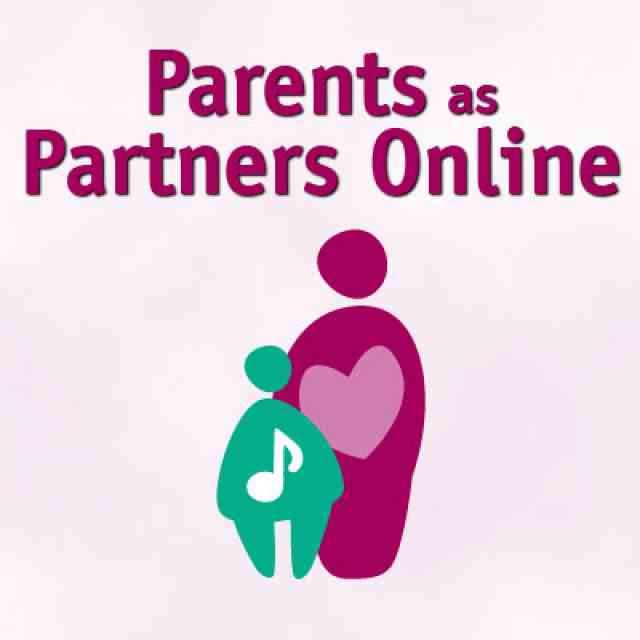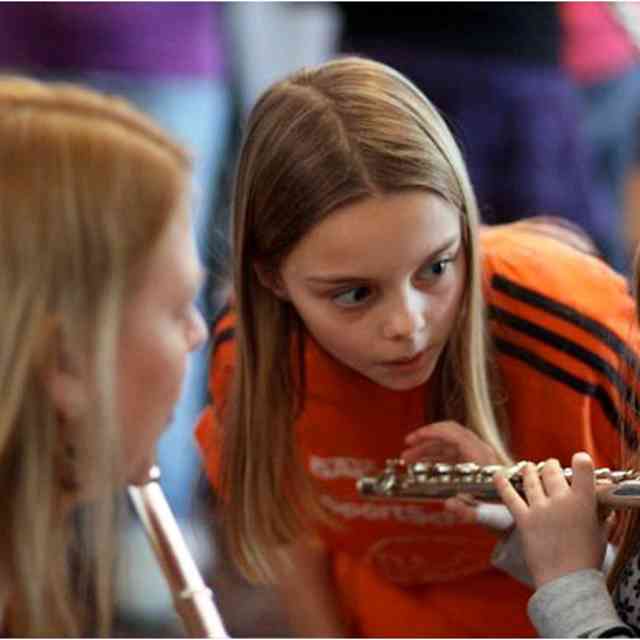From the Video Series, Parents As Partners Online 2015
Hi, I am Jenny Burton and I am going to talk about listening today. The name of my talk is “Play it Again Sam: How to Implement Listening in Home Practice.”
There are two kinds of listening as I have observed. One is passive listening where you just have the CD going on in the room quietly in the background. The other is active listening. Active listening can be clapping to the pulse of the music, it can be tapping your foot, it can be dancing around the room. For older students you can follow along on the page to see where the various artists are shifting or how they use vibrato, how the expression is occurring with their intensity of crescendos. Those are two different kinds of listening.
What are some things you can do on a daily basis to make your child learn easier?
One is to listen whenever possible. So when do we listen? I would suggest listening whenever the child is in the home environment. Have the CD going on when they get up in the morning, put it on quietly during breakfast, all the times when they come home from school, anytime they are in the home. You could provide a CD in their room if that is where they do some quiet playing. You could have a CD player in the den, you could have one in the kitchen. One family put the CD player in the pool area and listened to music while kids were in the pool. They neighbors were saying, “I really like that one, play that one again.” When do we listen? Anytime we can.
One personal testimony I have for my own experience when I was at grad school here at Stevens Point, I had a full student load, I had a part time job, and I did not have time to listen. I said to Ms. Aber “I already know how to read, I don’t need to memorize.” She looked at me with that wonderful gaze of hers and said “You will listen, and you will memorize.“ And I thought, “Oh boy, now I have to memorize.” Well, this ol’ girl memorized ten books in a year and a summer by listening overnight. It really happened. I put the cassette player on real softly on an endless loop and by golly, I listened and I memorized that amount of material, so it is possible.
A parent from MN, we will call her Julie, has several kids, and when she heard me share this testimony with her, she tried it out. This is what she said. “I am especially glad you mentioned the night listening because it is difficult for us to carve out time during the day. Music practice all morning with my homeschooled kids and school work all afternoon. Before I heard you talk at the Stevens Point Institute I tried to remember to play their Cds while they ate breakfast, but it was hit or miss. Thus the night listening was the perfect solution for us.” We will hear some more of her testimony later in the talk.
Where do we listen? The car, the van, the house. In Dr. Suzuki’s time, he would strap a cassette recorder on the child’s back. So this idea of having listening wherever the child was, is not new, and it works, that is the powerful thing about it. How often do we listen? As often as possible, we just cannot listen too much. In fact, I would suggest that people make copies of their CD or buy several copies or download them off the internet. Put them on your iPad, your iPhone’s, wherever you can have the music around you and as often as possible.
What do you listen to? Well of course the Suzuki CD’s, but I would recommend that you enrich your child’s listening. Joanne Bath, when she starts her students in North Carolina, she has them buy all ten volumes and has them listen to all those CD’s even as a Pre-twinkler.
My parents often say, “Well what else can we listen to? Does it have to be the Suzuki CD?” (*See Note)
Some other suggestions would be Julia Fischer with her wonderful Bach concertos. Hilary Hahn with the Mozart Violin Sonatas. Joshua Bell, anything he records is always heart rendering. He has one CD called the Romance of the Violin that is very wonderful. Andrew Manze’s Handel Violin Sonatas. My personal favorite is Izhak Perlman. I love how he plays from his heart. His Cinema Serenade is really a wonderful addition to any listening library. For bedtime listening Beethoven at Bedtime is a great CD, Vivaldi Adagios, Linda Ronstadt’s CD “Dedicated to the One I Love” has soothing wonderful pieces. Yes, supplementary listening is good and it is valuable and it gives everyone in the family and in the household something to listen to other than the Suzuki CD’s and that is fine.
Who’s responsibility is it for listening? I believe it is the parent’s responsibility. It is the number one thing you can do to help your child learn quickly and fast and easier. Imagine if you can avoid having your child unlearn pieces that they have played incorrectly because they don’t hear it in their heads. If they are listening enough the students can self correct and save time and learn easier and quicker. Teenagers can take additional responsibility by listening on their iPads, MP3 players, they like to do that, it’s where they are and that can be their job to load their Suzuki Cd’s onto their gizmos, iPhones, and other stuff.
So that brings us to listening equipment. There is a lot of stuff out there today. You can buy various apps for your devices, like The Amazing Slow Downer is a great app to help students so they can hear the piece at a slower tempo and can play along with it. The Music Trainer for Mac or iPhone is another one. Audacity is a free app for computers. Smart Music is a subscription you can get that includes all of the Suzuki pieces and repertoire and it has additional ear training exercises. This does come with a paid subscription, but it is excellent, it is worth it.
Another little warning I would recommend is to keep listening, even when you are a fine, fine reader. The very first time we play something when we are reading it. It creates an indelible track inside of our brain and it is like a template that you have and if you learn it incorrectly it is very difficult to undo some of that. Teenagers and more advanced players, please continue your listening and also find different sources of your advanced pieces to hear different interpretations and you can watch along with your music and you can see how one artist does a passage and compare it with another one, and then decide for yourself which one you like the best.
Some special listening projects that are tried and true and fun, I would like to share those with you. There is one called the Big Ear Project. We did that here in Stevens Point with all of our teachers and for every ten hours the child listens, they get a little sticker that was an ear. Every child had their name and for every ten hours they got an ear, and you saw this huge long columns of ears. Once a month we would have play-ins and the kids were given certificates for thirty hours of listening, sixty hours of listening, in the thirty hour increments and we did that for 100 days. At the end of the 100 days, we had a grand celebration to honor those students that were the number one listeners in their teacher’s studio. You should have seen the group of kids on stage proudly holding up their certificates and the big winners were given a CD of an artist of their instrument.
Rhonda Cole has a Special Listening Project. She asks every child to choose a piece outside of the Suzuki repertoire and write it in their practice sheet and then give a little feedback about it, what they learned about it. The only requirement is that they listen to it at least 3 times that week and participate in it. Older kids are asked to give the piece number, the opus number, the composer, state the period that it is from so it brings some music history into their lesson. So that is another way you can use your listening and enrich it.
In conclusion, let’s go back to the family from MN, Julie’s family. This is what she said about night listening. “The bottom line is, it’s making a difference in all three of my children. My oldest daughter Isabelle,7, listens to her violin and piano Suzuki repertoire books, nine books total, plus supplemental music all night long. Hours of classical music, and once the cycle ends it repeats, which means ten hours of listening every night. She has a great ear and she learns pieces very quickly, especially the violin pieces. She didn’t even need the music to learn the variation of Long, Long Ago in book two. I just gave her the starting note and she took off. Finally, before I started night listening I felt like I was tugging my son Daniel through quick sand trying to help him make progress on Twinkle. He insisted on playing an instrument like his older sister, but it was not an easy road for him like it had been with her, but now he does a beautiful job with Twinkle and he is a third of the way through book one repertoire. Yes, he is a year older, but I think the night listening contributed to this turnaround.”
I hope these ideas give you a chance of trying some new ways of listening in your home, and explore the value of sensitive loving human beings through listening.
*Note: The SAA does not endorse specific recordings (besides the standard Suzuki repertoire) for student listening, but it does encourage immersion and education in classical and orchestral instrumental music.







